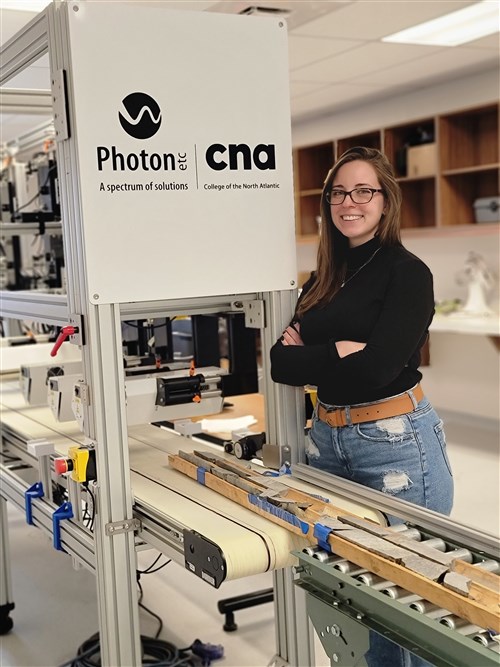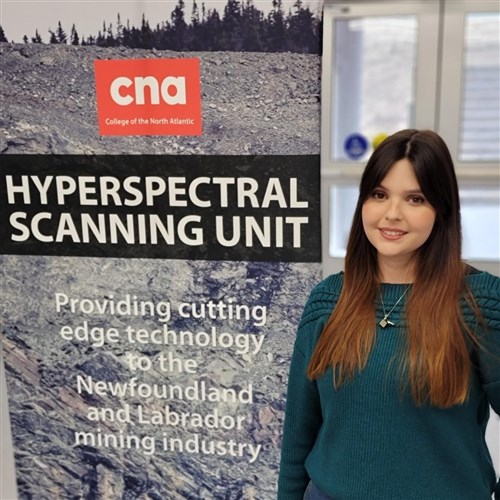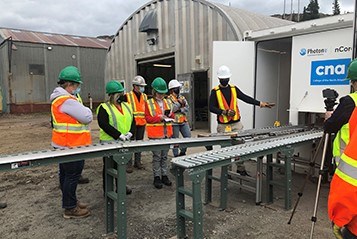ST. JOHN’S, NL – Women are pursuing careers in the mining industry now more than ever; just ask Stacey Parmenter and Halina Kondrasovas.
The pair are Faculty Researchers at the Office of Applied Research and Innovation (OARI) at College of the North Atlantic (CNA).
Parmenter, who started working at CNA as a Mineral Lab Assistant in 2019, says her current position has her working on the college’s new innovative mining technology – the Hyperspectral Scanning Unit (HSU).
 Stacey Parmenter, a CNA Faulty Researcher with the Office of Applied Research and Innovation (OARI), shown with the college’s Hyperspectral Scanning Unit. She encourages other women to become involved in sciences and mining and resource fields as career options.
Stacey Parmenter, a CNA Faulty Researcher with the Office of Applied Research and Innovation (OARI), shown with the college’s Hyperspectral Scanning Unit. She encourages other women to become involved in sciences and mining and resource fields as career options.
“My background is in geology, so I currently work as part of the HSU team to complete scanning and research of geologic materials using these hyperspectral cameras,” she said. “One of the cameras is capable of detecting the H
2O bond, so I’m also completing research into using hyperspectral imaging as a detection method of the moisture content within various materials.”
Originally from St. John’s, NL, Parmenter says she has had an interest in geology from a young age.
“I’ve always been interested in the sciences so going into geology felt like the right choice because the field draws from so many of the other base sciences. As I continued my studies, I became increasingly interested in the various technologies used within the mining industry. It’s definitely interesting to get to work with the HSU to see what kind of insights we can gain from this type of analysis.”
In addition to the work being done on the HSU, Parmenter is also conducting research on the use of Laser Induced Breakdown Spectroscopy (LIBS). CNA recently acquired a handheld LIBS device that is capable of detecting light elements (such as lithium) within a sample. These light elements are traditionally more difficult to quantify in the field.
“We are conducting research to determine if we can use this handheld LIBS as an aid during mineral exploration for deposits with light elements – which are becoming increasingly important as we transition towards greener energy sources.”
Parmenter has a Bachelor of Science in Earth Science from Memorial University (MUN) and a Master of Science in Earth Science from University of Waterloo. She says she would whole-heartedly encourage other women to work in the geology field as it offers a lot of options.
“The field of earth science is made up of a broad range of different areas, this includes the mining and resource industries, but also includes many other specialized fields, such as hydrology and environmental sciences, geophysics, and many others. I would definitely recommend pursuing a career in earth science to others as there is an opportunity to pursue many different subject areas, you often get to work outdoors and there is lots of opportunity to travel.”
When it comes to this male-dominated field, she says while it’s come a long way, there is still room for improvement.
“Traditionally, the mining industry is a male-dominated field, but it has been getting better in more recent years. I’ve always found it interesting that while I was going through school there was roughly a 50-50 split, so the presence of women within the industry is obviously growing, and yet those numbers don’t seem to translate to the mining industry where the number of women in the field remains much lower than in other areas.”
 Halina Kondrasovas, originally from South America and living in St. John’s, is also a Faculty Researcher at CNA’s Office of Applied Research and Innovation (OARI). Mining has been a big interest for her, and she works closely with the college’s Hyperspectral Scanning Unit.
Halina Kondrasovas, originally from South America and living in St. John’s, is also a Faculty Researcher at CNA’s Office of Applied Research and Innovation (OARI). Mining has been a big interest for her, and she works closely with the college’s Hyperspectral Scanning Unit.
Originally from South America and living in St. John’s, Kondrasovas agrees with Parmenter.
“Geology in general is still male-dominated, though we have seen an increasing number of women,” she said. “In the last couple of years in Brazil, geology classes have a 50-50 split or even more women than men. However, some fields in geology are still commonly known as ‘girl fields’, such as environmental, and other are ‘boy fields’, like mining.”
Kondrasovas is also working on the HSU and says that mining was of interest to her right from the start.
“Since the beginning of my undergrad mining was one of the fields that seemed more interesting to me,” she said. “Hyperspectral came out later. Once I was able to understand more about how those kinds of mineral deposits were formed, I started getting interested in the different analytical techniques used to identify and characterize those.”
She has a Bachelor Degree in Geology and a Master’s Degree in Geoscience. She says she has high hopes for the next generations of geoscientists.
 Stacey Parmenter and Halina Kondrasovas, CNA Faculty Researchers with the Office of Applied Research and Innovation (OARI), were in Labrador West to attend the $4.5 million funding announcement to advance mining using one of the most advanced, high throughput hyperspectral drill core scanning units available globally. The event took place at IOC in Labrador West.
Stacey Parmenter and Halina Kondrasovas, CNA Faculty Researchers with the Office of Applied Research and Innovation (OARI), were in Labrador West to attend the $4.5 million funding announcement to advance mining using one of the most advanced, high throughput hyperspectral drill core scanning units available globally. The event took place at IOC in Labrador West.
“I would say that in general I’ve experienced more good than bad in this industry,” said Kondrasovas, who will have been working at CNA a year this July. “Things are improving with this new generation of geoscientists, and what I would like to see in the future is more engagement from our male colleagues in also taking a stand to recognize their own misconceptions and prejudices, especially to listen to female voices.”
For more information about CNA’s Office of Applied Research and Innovation and CNA programs, visit
www.cna.nl.ca.
-30-
Media contact:
Ryanne McIsaac
Content Specialist
College of the North Atlantic
709-643-7870
Ryanne.mcisaac@cna.nl.ca